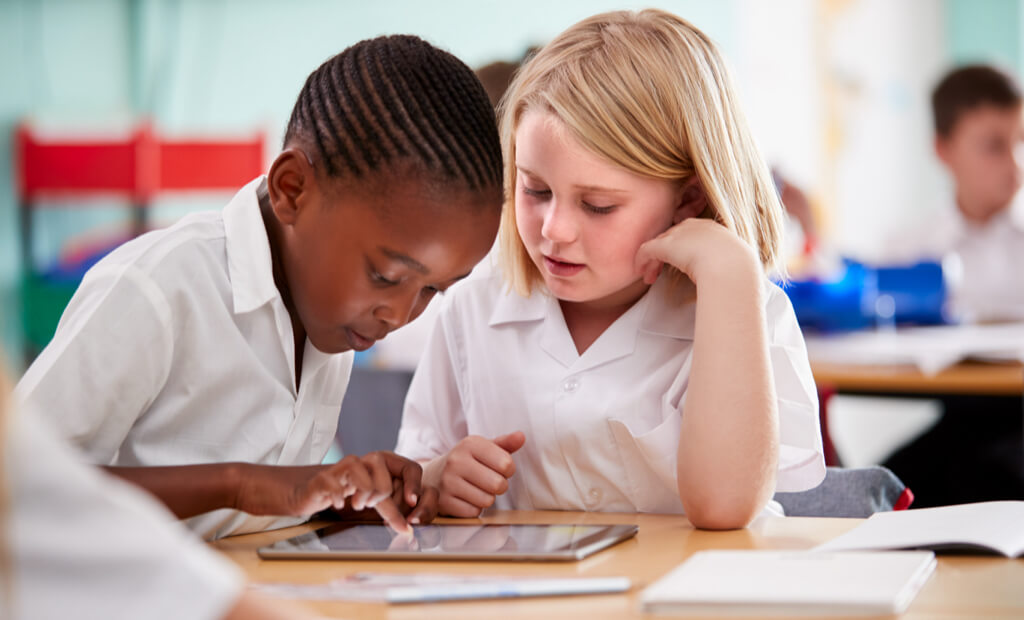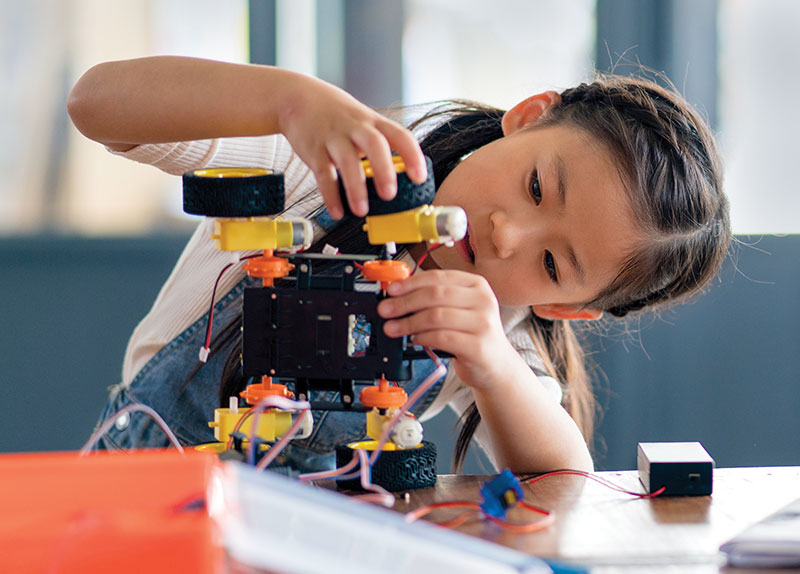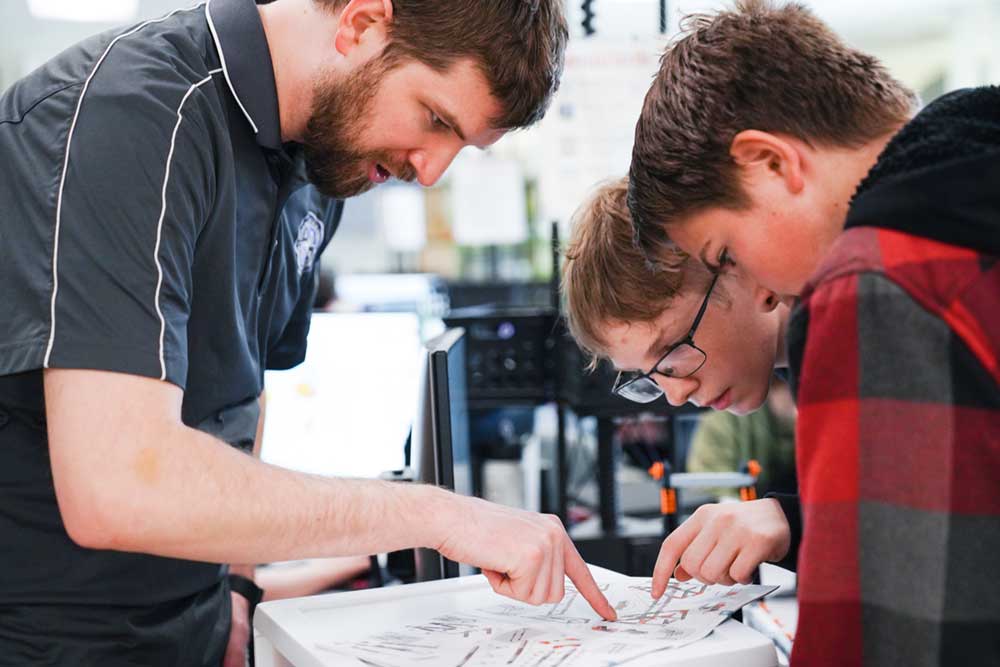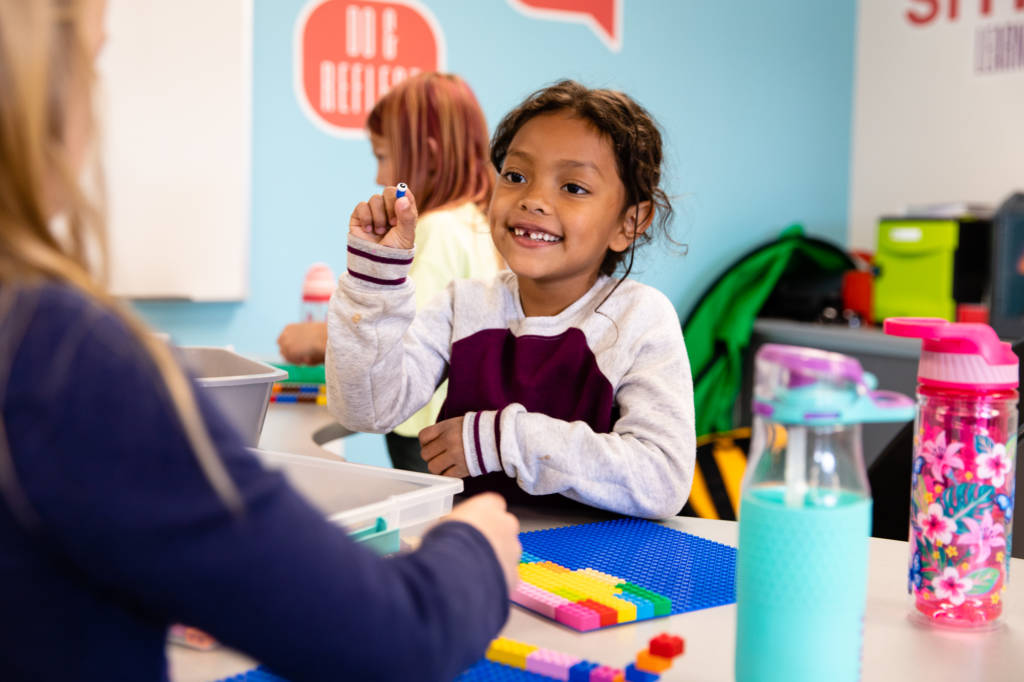Project Based Learning in Primary School: Kindergarten Through 2nd Grade
Project Based Learning (PBL) has continued to gain attention in K-12 education for its ability to achieve two major goals: teach core content and develop essential skills for lifelong success.
When learners engage in project-based learning, they make connections between what they’re learning in school and how it can impact their lives and the world around them. It allows them to not only develop problem-solving skills, but also learn how to collaborate effectively and think creatively. As learning shifts from direct instruction to hands-on, embedded learning, teachers see engagement and skyrocket in all grades. Project-based learning takes two competing goals, content mastery and skill development, and units them to elevate learning for students.
In this blog, we will discuss the benefits, challenges, and examples of PBL at the primary school level, and how you can implement it with your kindergarten through second grade students.
What Is Project-Based Learning?
Project-based learning is an instructional approach in which students learn by actively engaging with content to develop solutions to relevant real-world problems. Schools that incorporate project-based learning into kindergarten, first, or second grade classrooms will have learners working on long-term projects that are relevant to their lives and the world around them.
PBL is a teaching method and is distinct from assigned classroom projects, side projects, or extensions to a lesson plan — the project is the vehicle for teaching the important knowledge and skills students need to learn. The project itself contains and frames both the curriculum and instruction.
Keep the following elements in mind when designing and implementing PBL:
- It’s relevant: Assigned projects address authentic, real-world problems.
- It’s interdisciplinary: It should incorporate skills and knowledge from different subjects and disciplines.
- It’s student-centered: The learners should have the agency to guide their own learning with the support of a skilled educator.
- It’s a vehicle for learning: The solution will require the use of higher levels of thinking beyond recall, including analysis, application, and creativity.
- It’s an extended learning opportunity: The process will take place over an extended period of time, requiring at least several days of work.
If a project can be done within one day, incorporates only one subject area, and does not allow the learner to determine how they may solve the problem, then it is not PBL.
At SmartLab, we believe that collaboration is another critical element of project-based learning. While PBL can be done individually, collaboration in pairs or small groups takes learning to the next level. It promotes knowledge building, critical thinking, and development of interpersonal skills. .
PBL in the Kindergarten Through Second Grade Classroom
Project-based learning has been used to great effect in high school and elementary school environments, and studies have shown that PBL can be used in any grade level or content area to boost academic achievement.
PBL in primary school should incorporate a range of skills—including basic mathematics, literacy, and scientific exploration—into units or themes centered around a complex problem. Instructors should guide learners to explore the central problem utilizing a variety of first-hand, authentic resources, ranging from books and videosto content experts and field trip opportunities. Throughout the learning process, students should have access to tools and materials that allow them to explore, discover, and create their solution.
To ensure that PBL units are appropriate for learners at the primary level, keep the following tips in mind:
- PBL assignments are lengthier than one-off projects, so keep things manageable for students when you introduce them to this style of learning. Break the project into smaller chunks or tasks that connect together and build toward a larger goal.
- Design every project to ensure it aligns with academic standards and connects to real-world applications to engage learners’ interests.
- Look for ways to enhance the learning experience by making it easier for students to utilize tools and apply subject-specific concepts to their projects. Look for programs, platforms, and environments such as SmartLab HQ that make it easier to build a project-based learning environment in your school.
- Ensure that PBL assignments involve as much hands-on action as they do learning concepts or applying critical thinking skills. Plan to integrate your instruction “just in time” as learners engage in the hands-on work of the project.
- Where possible, find areas to foster collaboration and bring in diverse perspectives. Try to foster collaboration outside of the school by contacting community experts and utilizing community resources.
- Be sure to set plenty of time for the project, allowing learners the opportunity to ask questions and acclimate to the process, and providing instructors the time to explain and provide guidance.
- Track learners’ progress throughout the project to check for understanding and monitor their level of engagement.
- At the end of each project, ask learners to reflect on what they enjoyed or learned and be sure to celebrate their achievements. Find ways they can share with authentic audiences.
As an instructor, you want to encourage your learners to discover their own interests and strengths through PBL’s experiential learning process.
Here’s how PBL elements may look when implemented at the Kindergarten and Primary level:
| Relevance | The assignment is relevant to a problem specific to their class or community. |
| Interdisciplinary | The solution will require a range of tasks and grade-level skills, from reading and communicating to math and creative design. |
| Student-centered | Students will determine a list of key elements of the solution together, but also build their own unique solutions. |
| Vehicle for learning | Arriving at a solution will require facilitation from an educator to engage in high levels of learning, including evaluating options and developing their own answers. |
| Learning process | The project will occur over a few days as students move through the project stages, allowing for reflection and iteration,, culminating in a final presentation. Learn more about SmartLab’s Learning Process for K-12 project-based learning. |
Looking for even more advanced PBL engagements? Explore project ideas for high school classrooms >>
Benefits of Project-Based Learning in Kindergarten and Primary Classes
As with other grade levels, project-based learning offers important benefits for kindergarten and other primary students. At this early stage of learning, PBL:
- Introduces learners to important 21st century skills—including critical thinking, problem-solving, and communication—that go beyond rote memorization.
- Is developmentally appropriate for kindergarten and primary students, as they learn in really concrete ways.
- Is great for emergent bilinguals to be able to see things in action and collaborate with other students, both of which aid their oral language development.
- Offers learners more opportunities to practice teamwork and collaboration, opening them up to more diverse perspectives.
- Improves learners’ attitude toward education by providing them with more ownership over it, increasing their engagement and motivation.
- Avoids the placement of academic work into separate silos like math or grammar by encouraging learners to make connections across content areas.
- Provides plenty of opportunities for formative assessment and intervention during the learning process to help students meet learning objectives.
[Students] develop critical thinking skills, hone teamwork and collaboration, and are instilled with a persistent drive to solve problems. It’s teaching them that it’s OK to fail while developing new solutions – ensuring their resilience and career-readiness.
— Rick Knotts
Science Director
Prince of Peace Christian School
Carrollton, TX”
Challenges of Project-Based Learning in Kindergarten
Because it is a different approach to traditional instruction, project-based learning comes with its own unique set of classroom challenges. Here are a few of the top challenges of implementing project-based learning in kindergarten and primary school classes:
- Structure. Because students will have an increased role in identifying and creating solutions as part of PBL, structures are needed to help small learners tackle these big problems. To keep learners on-track and engaged, it’s important for instructors to map out the standards and processes that will be covered across the units or themes and consider how they’ll guide learning. However, that plan should be flexible and instructors will need to be comfortable with a level of uncertainty and discovery. Having an established process to follow is especially helpful, which is why we offer the SmartLab Learning Process for PBL classrooms.
- Lack of resources. As PBL is very hands-on, learners will need access to different resources, such as project materials and digital technology. Unfortunately, some materials may not be easily accessible or the school may have strict budget constraints that will hinder some aspects of a PBL project. Teachers may need to purchase these materials or find ways to get them from other sources. SmartLab provides the materials necessary to engage in year-long project-based learning.
- Time management. Creating a lesson that is too ambitious or challenging can lead to complications, frustration, and loss of time. Starting with a short project helps learners get acclimated to the PBL process, allowing them the confidence to work more independently for subsequent projects.
- Offering support. PBL is a different style of teaching for some instructors, requiring some additional planning. Instructors need to employ more differentiated instruction and be more responsive to students’ needs and where they are in the process. Formative assessment is critical to identify needed instruction and remediation. Knowing how and when to provide the necessary amount of support for each learner is a learned skill that develops over time.
- Assessment. PBL assessment can be difficult, especially if goals and standards aren’t clearly defined at the start. Assessment during projects can be complicated as learners will work at different paces, and reach different parts of their project at different times. While it may look different in primary grades compared to middle or high school, developing authentic learning and assessment practices is important for success.
Learning solutions such as SmartLab can assist classrooms in creating and implementing learning environments that facilitate project-based learning and meet learner needs.
| Core Components | Customized SmartLabs can include all necessary resources for projects, from custom floor plan and necessary technologies to hands-on materials, including: Physical environment Pedagogy/approach Curricular resources Professional development Hands-on materials |
| Professional Development | SmartLab provides teachers professional development and training on long-term coaching so they’re adequately prepared to implement PBL lessons and support student learning. |
| Curriculum Design | Teachers use SmartLabs to facilitate projects that are relevant to learners’ lives and interests—and so are more engaging—to help maintain motivation through longer projects. |
| Instructional Resources | SmartLabs include many instructional resources, such as a variety of rubrics and portfolios, to aid instructors in measuring learners’ progress and to assess their learning. |
Benefits that I have observed from having the SmartLab is that students get to experience things that they wouldn’t normally get to experience… They’re learning that some of the things that they don’t like and that’s okay, because that’s part of the experience, is find where you fit best and help lead them in a way that’s going to grow them as a student, grow them as a learner, but then also give them the opportunity to see if it’s something that they may decide to be passionate about for the rest of their life.
— Courtney Norton
Facilitator
Dunbar Intermediate School
Okmulgee, OK
Project-Based Learning Ideas for Kindergarten Classrooms
A PBL project can’t be a one-size-fits-all approach, as each learner has their own unique needs. Projects should be adapted to meet the needs of your students and the curriculum through a variety of hands-on, engaging activities. Start by considering the following elements:
- What are students responsible for learning? The first step is to consider what you are responsible for ensuring the students learn. Which learning standards will be most applicable or valuable? How are concepts or skills connected across content areas?
- What is the context? Remember that PBL projects should be designed around real-world problems or concerns. Much of the work of PBL is connected to personal, community, and world problems or needs. Ask your students what they’re interested in. Consider what challenges the classroom is facing. Does anything line up with upcoming topics or current events?
- What content and resources are available? Keeping in mind the skills and knowledge you want learners to develop over the course of the project, what do you have available for them to work with? Are they able to make use of tools, equipment, materials. Consider asking what books, websites, and school resources can help learners conduct research and find information as they work on their project.
- What question(s) will they answer? Determine the actual, achievable goal or goals that you want to guide the students toward. What complex questions, problems, or challenges will they be addressing? Be sure that the final product or result the learners arrive at not only provides answers, but also meets established learning standards.
PBL projects for K-2 students should revolve around age appropriate tasks that require some planning and creativity. Here’s some general ideas for projects:
- If there’s a class pet, ask learners to create a care guide for it by reading about it, watching informational videos, and by observing it. See if they can design an ideal habitat using objects from outdoors.
- If there are class plants that are not thriving, ask the class to develop a structure that would help them. Students could learn about plant growth and determine their needs, which would involve tasks like learning non-standard units of measurement or reading non-fiction.
- Have learners plan different healthy meals by using the food pyramid and toy foods. Consider a field trip to the school cafeteria.
- Ask learners to consider how the larger community is growing. How might they build a city for the needs and growth of their community? This could easily tie into different fields of science, from considering natural resources, to mapping with geography, and building new housing.
I am really focused on the learning that the students come away with in the process. I heard a statistic one time that something like 60% of the jobs these kids will have in their future, their careers don’t even exist yet… And so, knowing that, as an educator, that all of these jobs that they’ll be doing are jobs that we can’t even prepare them for, the process of the SmartLab is the best way to teach them how to learn so that they can carry that forward in their futures.
— Misti Newby
Facilitator
Black Canyon Elementary
Grace, ID
As for specific ideas, here’s one example of a PBL and STEM project that’s designed for K-2 Primary students.
MegaMaze (Let’s Go Code)
PBL Goal: Build introductory computer science knowledge and computational thinking skills while practicing oral communication and use of positional words.

Students actively approach their learning experiences with Let’s Go Code, taking on the roles of programmers and engineers and using their whole bodies in practicing and applying transferable coding concepts. Robotics serves as a great platform for young learners because of how it promotes abstract and sequential thinking skills.
In small groups, students plan out a maze using large foam tiles, placing various parts on certain tiles to indicate objectives for the robots to accomplish. Learners work together to plan out the best path for the robot using cards that show different actions and directions for the robot to turn or move.
As students navigate their robot group members through the maze, they learn basic sequencing and take on the perspectives of others to achieve a goal. Though simple, this project helps learners build essential STEM knowledge and skills from an early age, paving the way for more complex challenges later.
While the original objectives generally relate to collecting parts to upgrade or repair the robot, they can easily be embedded within an authentic classroom or community problem:
- Our new students are having a hard time finding their way in the school. How can we help them get to their classroom?
- All animals have basic needs. How do animals in our area navigate their habitat to meet their basic needs?
- Our book character is always late for school! How can we help them travel more efficiently to get there in time? How can we travel most efficiently in our community?
Each of these authentic problems require students to apply core content and essential skills to develop solutions.
| Our book character is always late for school! How can we help them travel more efficiently to get there in time? How can we travel most efficiently in our community? | |
| Language Arts | CCSS.ELA-LITERACY.RL.1.3 Describe characters, settings, and major events in a story, using key details. |
| Math | CCSS.MATH.CONTENT.1.OA.C.5 Relate counting to addition and subtraction (e.g., by counting on 2 to add 2). |
| Social Studies | a. Explain that maps and globes are different representations of Earth. b. Describe locations using terms related to direction and distance. For example: Forward and backward, left and right, near and far, is next to, and close. |
| Essential Skills | Critical-thinking, communication, collaboration, problem-solving |
It really excites people who tour our school when they see the [SmartLab]. Especially when they hear that children as young as kindergarten are learning to code and animate.
—Kathryn Hildreth, Facilitator
12 other project-based learning engagements to start using today >>





